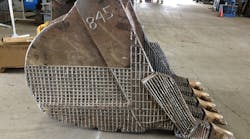Somewhere in the Texas Hill Country, a few contractors who wish to remain anonymous slice through the native limestone, a.k.a. Austin chalk, blue shale, not with a trencher, but with a bucket mounted on an excavator. Most contractors would scoff at the notion.
But these contractors who install water and sewer utilities for new subdivisions feel like they have found their "secret weapon." The result is similar to a trencher, but the cost is much cheaper — and because it is a bucket attachment, the only wear parts are the teeth.
"I've been selling these for about a year and a half," said Duke Arnold, manufacturers' representative in Arlington. "It's so simple. There are no hydraulics involved. Its power comes from the curl function, the downward force and the crowd force — the principles of using a bucket along with the power of the excavator — to create a 100-percent breakout force when each tooth comes into contact."
Leading Edge Attachments, Inc. president, Lee Horton, P.E., of Jefferson, Massachusetts, describes the reason for the Multi-Ripper Bucket's power, "The staggered ripper teeth fracture the substrate in sequential order. No two ripper teeth align with each other, resulting in the maximum breakout force being applied sequentially to each tooth. The distance from the excavator stick pivot to the tooth tips is also shorter than the standard bucket for the machine. The shorter distance actually multiplies the tooth tip force. The rolling of the Multi-Ripper Bucket always provides the full multiplied breakout force individually on each tooth so that the substrate is ripped out by each individual tooth lifting action. The result is a relatively flat trench bottom."
The Multi-Ripper Bucket walls are made of 3-inch-thick Swedish Hardox 400 steel, making it extremely durable. Leading Edge Attachments manufactures this design in sizes that will fit machines from a skid steer or mini excavator all the way up to a 220,000-pound excavator.
Because these powerful ripper teeth are mounted onto a bucket, one excavator and operator can trench and remove spoils, performing the work normally done by two.
This bucket may not be appropriate for every trenching situation, and size and power of the host excavator also plays a major role. However, it stands to reason that a bucket attachment is much less expensive than renting or purchasing an entire trenching machine.
These Texas contractors are not telling, but they are bidding lower because they can.


